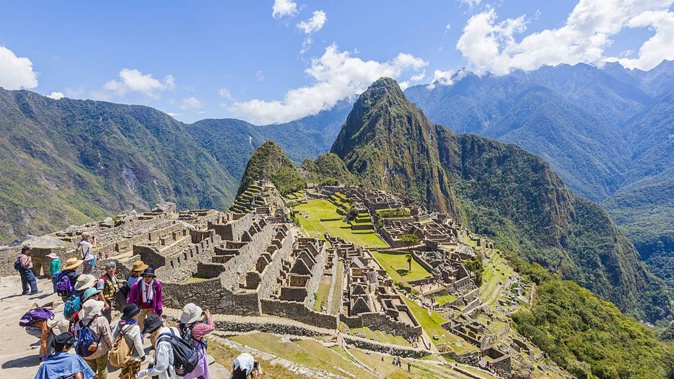
Machu Picchu is preparing to open its mountain trails to another 700 visitors a day from January, as Cusco and the Peruvian Tourism industry climb back from a challenging year.
The beginning of 2024 couldn’t have looked any more different to 2023. Earlier this year 5000 tourists were trapped in the Incan tourism hub of Cusco after the country’s elections descended into violent protests.
A further 800 trampers were stranded at the trailhead of the Inca trail - the four day trek that passes through the area.
The site of Peru’s top tourist attraction was closed for almost a month at the beginning of 2023, while tourism operators negotiated to restart the trail.
Now the daily visitor cap to Machu Picchu is being boosted to 5,600 visitors a day to make up for this lost time and lost tourism revenue. But not all operators are welcoming the additional footfall to the fragile Unesco heritage site.
“Tourism to Peru has been through a difficult time and has made a slow recovery this year, so I welcome any efforts by the authorities to attract more visitors to the country,” says Fernando Rodriguez, general manager in Peru for Intrepid Travel tour groups.
“At the same time, overtourism has long been an issue at Machu Picchu and on the Inca Trail.”
The raising of the cap on visitors is seen as a slow undoing of conservation limits that were put on the tourist attraction in 2019. Visitors were also confined to four circuit paths through the National Archaeological Park, to protect the 600-year-old mountain kingdom.
The Peruvian heritage body had limited visitors to 3,200 online tickets a day, and 1,000 walk up visitors. Prior to this limit the Unesco heritage site saw over 6,000 visitors a day, particularly during peak times.
/cloudfront-ap-southeast-2.images.arcpublishing.com/nzme/K3FUFTFCUJH5REV76VOZ4YVWHM.jpg) Great Inca Road: Intrepid Travel's Fernando Rodriguez says that Peru is full of Incan trails, beyond Machu Picchu. Photo / Ruben Hanssen, Unsplash; Supplied
Great Inca Road: Intrepid Travel's Fernando Rodriguez says that Peru is full of Incan trails, beyond Machu Picchu. Photo / Ruben Hanssen, Unsplash; Supplied
Rodriguez says that while tourism has rebounded at the tourist site, other parts of Peru have yet to see the crowds return.
“Tickets for the four circuits at Machu Picchu are fully sold out for December,” says Rodriguez. “But there’s still around 60 per cent availability for the Inca Trail trek on the remaining days of the year.”
Crowding is back to levels seen pre-pandemic, particularly at the peak visitor times of sunrise and sunset.
While the effort to revive the tourism industry is well intended, the Intrepid Country manger thinks the inbound tourism could be better spread across the Andes rather than focusing on the fragile Unesco site.
Tourists can help the region and avoid the crowds by doing a bit more research for alternate trails through the region - of which there are many, says Rordiguez.
“Machu Picchu is beautiful, but there’s so much more to explore in Peru,” he says.
“The Great Inca Road which is made up of ancient Inca trade routes cutting through the Andes and every bit as significant and special as its more famous counterpart – it just doesn’t have the crowds.”
Off-peak visitors also help spread the load across the Andean tourism hub.
“Consider visiting during the off-season periods of March to April and September to November.”
These periods avoid the rainy season but also the summer peak tourism levels.
“This not only offers a more pleasant travel experience but also helps distribute tourist income more evenly throughout the year, benefiting the local economy and combatting over-tourism.
/cloudfront-ap-southeast-2.images.arcpublishing.com/nzme/2F34VGF5GRHKDGPRI3AROUPFYI.jpg) Overview of Machu Picchu, agriculture terraces, Wayna Picchu and surrounding mountains in the background
Overview of Machu Picchu, agriculture terraces, Wayna Picchu and surrounding mountains in the background
Why is Machu Picchu famous?
Machu Picchu was included in the 7 New Wonders of the World as one of the world’s most spectacular cultural monuments, to mark the millennium in 2000.
The ‘Lost City’ of the Andes was abandoned in the 1600 during the Spanish Conquest. The citadel was only ‘rediscovered’ by tourists in 1911 and popularised stories of the legend of ‘El Dorado’ a mythical forgotten city in the Andes.
Can you still walk on Machu Picchu?
Since 2019 tourism to the Inca Citadel of Machu Picchu has been far more tightly regulated, meaning tourists can no longer walk where they like. Instead there are four circular paths which visitors must stick to.
The site is still on the Inca Trail hiking route, and a popular stop off point for walkers.
Why was Machu Picchu shut down?
The site was closed down on January 21 this year - stranding hundreds of tourists - during ongoing civil unrest in Peru. The president Pedro Castillo was ousted by Congress at the beginning of the year and jailed on charges of conspiracy after a coup.
Is it safe to go to Peru right now?
Following the violent protests at the end of 2022 and beginning of 2023 foreign travel advisories were updated to avoid unnecessary travel to Peru. 66 people were killed in clashes with police. Strikes brought travel and tourism to a halt at the beginning of 2023.
While MFAT still advises visitors avoid non-essential travel to the departments of Puno over ongoing civil unrest, most of the protests have been resolved and tourism has returned to Cusco and Lima.
“Despite initial concerns about the first anniversary of the protest on 7th December, only minor activity took place,” says Rodriguez.
MFAT’s general advice to New Zealanders travelling to Peru is to take out comprehensive travel insurance including cover for adventure activities and medical evacuation by air.
“The safety standards of some transport and tour operators can vary.”
Take your Radio, Podcasts and Music with you









